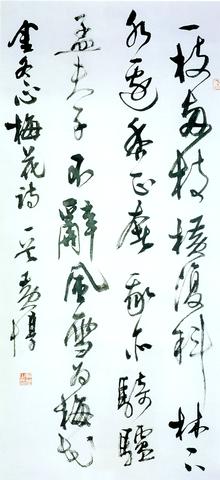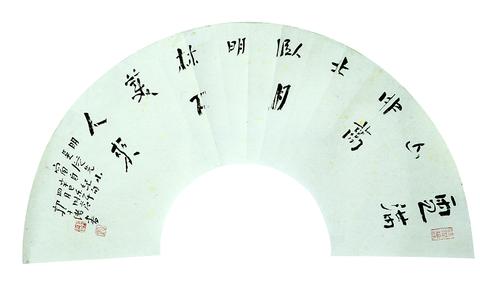At a time when a large number of Taiwan's contemporary calligraphers are relying on bright hues and challenging long-adhered-to guidelines in order to bring new life to the once solely black-and-white art form, their peers in China are taking a less radical route.
Openly flaunting their indignation to many of the rules that govern calligraphy and transforming works into colorful, abstract Dali-esque odysseys, works by local contemporary calligraphers are a stark contrast to those produced in China.
Contemporary calligraphers in China are instead referring to the Bible of calligraphy, the Lanting Preface (蘭亭序) for inspiration.

PHOTO: COURTESY OF HO CHUANG-SHIH CALLIGRAPHY FOUNDATION
Penned by Wang Xizhi (
His book did not enjoy the acclaim he expected, however. Instead of hailing it as a literary masterpiece, scholars dismissed much of its contents. Wang's penmanship, however, didn't go unnoticed.
Scholars were soon praising Wang, not for his literary skills, but for his stroke-perfect calligraphy; the style that was to set the standard to which less radical calligraphers have since aspired.

PHOTO: COURTESY OF THE HO CHUANG-SHIH FOUNDATION
While a recent exhibition in Taipei featuring works by contemporary Taiwanese calligraphers caused conservative heads to look on in horror, the exhibition -- which opens today at the Ho Chuang-shih Calligraphy Foundation (
Featuring works by members of the Suzhou-based calligraphy association, the Tsang Lang Society (
The works are all produced with black ink and all adhere stringently the rules of calligraphy as laid down in Wang's weighty tome. Rules dismissed as out-dated by their local peers.

COURTESY OF THE HO CHUANG-SHIH FOUNDATION
Members of the Tsang Lang Society don't create random lines on a page, nor do they separate or mold the basic lines, hooks and dots of any characters to suit their whims.
"[The works are] a very different approach to that of many local modern calligraphers," says Gary Ho (
The way in which the society has attempted to bring the ancient art form into the modern world and managed to keep their works untainted by what some local scholars have been known to refer to as "contemporary clutter," has led to high praise from some of Taiwan's leading calligraphers.
"The society has developed its calligraphy and not veered radically away from the teachings of the great masters of past, which is one of the most endearing factors of any exhibition by the group," states Du Chungao (杜忠誥), professor at Taiwan Normal University. "The calligraphy is pure and uncorrupted."
Formed in 1987, the society is far from China's largest calligraphy society. In fact, it's one of the smallest with only 40 members. Since its founding, however, works by its members have been well received, both at home and abroad.
The group has held successful exhibitions throughout Asia, Europe and North America. The group is now one of the most influential contemporary calligraphy societies in China.
"One of the reasons the group has become so well known is due to the age of its members and the fact that we not only create new works, but spend time researching calligraphy," explains Huang Dun (黃惇), one of the groups founding members and professor at the Nanjing Arts Institute (南京藝術學院).
Although based in Suzhou, the society boasts a nationwide membership. Which, according to Huang, makes it one of the most unique groups in China and ensures that exhibitions by the group are highly individual affairs.
"Though very subtle, there are big differences between calligraphy from China's northern and southern regions," said Huang. "Whereas Beijing-based ones are inclined to adhere to uniform guidelines and produce very traditional-looking works, those in the south use a more free-flowing style and are slightly more radical."
This exhibition is the second time the society has been invited to display its works in Taiwan. The first time was over 10 years ago when a handful of works were exhibited at the Taipei International Arts Center (台北國藝中心).
While the exhibition includes works by all of the society's members, Huang was unable to bring many of the groups' larger and more eye-catching works. "I couldn't get them on the airplane," Huang said.
When not putting brush to paper, members of the group are active participants in the International Lanting Research Forums (蘭亭序國際學術研討會).
The series of forums began in 1995 and is now held annually in cities throughout the region. Here scholars, historians and calligraphers from around the world hotly debate Wang's work and compare both traditional and contemporary calligraphic methods and concepts. The long-term plan of the forums is to ensure that calligraphy, while developing to suit modern audiences, doesn't stray too far from its historical roots.

May 26 to June 1 When the Qing Dynasty first took control over many parts of Taiwan in 1684, it roughly continued the Kingdom of Tungning’s administrative borders (see below), setting up one prefecture and three counties. The actual area of control covered today’s Chiayi, Tainan and Kaohsiung. The administrative center was in Taiwan Prefecture, in today’s Tainan. But as Han settlement expanded and due to rebellions and other international incidents, the administrative units became more complex. By the time Taiwan became a province of the Qing in 1887, there were three prefectures, eleven counties, three subprefectures and one directly-administered prefecture, with

President William Lai (賴清德) yesterday delivered an address marking the first anniversary of his presidency. In the speech, Lai affirmed Taiwan’s global role in technology, trade and security. He announced economic and national security initiatives, and emphasized democratic values and cross-party cooperation. The following is the full text of his speech: Yesterday, outside of Beida Elementary School in New Taipei City’s Sanxia District (三峽), there was a major traffic accident that, sadly, claimed several lives and resulted in multiple injuries. The Executive Yuan immediately formed a task force, and last night I personally visited the victims in hospital. Central government agencies and the

Among Thailand’s Chinese Nationalist Party (KMT) villages, a certain rivalry exists between Arunothai, the largest of these villages, and Mae Salong, which is currently the most prosperous. Historically, the rivalry stems from a split in KMT military factions in the early 1960s, which divided command and opium territories after Chiang Kai-shek (蔣介石) cut off open support in 1961 due to international pressure (see part two, “The KMT opium lords of the Golden Triangle,” on May 20). But today this rivalry manifests as a different kind of split, with Arunothai leading a pro-China faction and Mae Salong staunchly aligned to Taiwan.

As with most of northern Thailand’s Chinese Nationalist Party (KMT) settlements, the village of Arunothai was only given a Thai name once the Thai government began in the 1970s to assert control over the border region and initiate a decades-long process of political integration. The village’s original name, bestowed by its Yunnanese founders when they first settled the valley in the late 1960s, was a Chinese name, Dagudi (大谷地), which literally translates as “a place for threshing rice.” At that time, these village founders did not know how permanent their settlement would be. Most of Arunothai’s first generation were soldiers